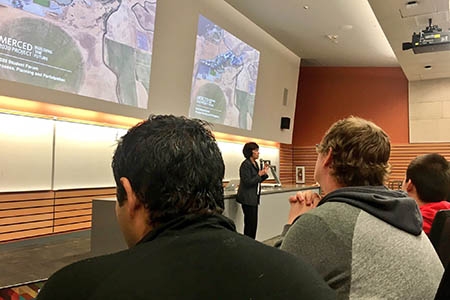Administrators Offer Merced 2020 Project Update to Students
 Last week’s student forum on the Merced 2020 Project started with a history lesson.
Last week’s student forum on the Merced 2020 Project started with a history lesson.
Space constraints are nothing new at UC Merced. When the campus first opened, Chancellor Dorothy Leland said, students took classes in interesting makeshift spaces such as the California Room.
“Can you imagine that?” she asked attendees. “One hundred students utilizing the California Room as a space to learn, grow and interact with faculty. In fact, class labs were held at Castle Air Force Base. Students traveled together on CatTracks to get there.”
Eleven years later, space is still an issue. Leland said the campus is operating at a 40 percent space deficit right now. Though overcrowding affects every unit on campus, she acknowledged the difficulty faced by students in coping with regular space issues on top of those created by beginning construction on the Merced 2020 Project.
“The beginning of the semester was not ideal,” she said. Space is only getting tighter. “The Merced 2020 Project will not only make up the space deficit, but allow us a modest growth for the future.”
Vice Chancellor for Student Affairs Charles Nies and Merced 2020 Project Marketing Coordinator Richard Cummings led the presentation portion of the Dec. 8 forum, which was designed to address the particular needs and concerns of students regarding the project and its effects on campus operations.
Cummings, who handles communications for the project, walked attendees through the project website, drawing particular attention to the 10-day construction advisories. The site is the place to keep up with construction and find out what’s coming.
Like the university’s pioneering class, students today have the opportunity to make their voices heard and inform the future of the campus’s development. Students are invited to take part in conversations regarding the planning and use of specific buildings in addition to the repurposing of existing spaces.
The project’s buildings and their locations are already planned, but Nies said other details, such as floor plans, have yet to be determined.
“Student input will be important in deciding how these new spaces should be used,” he said.
Campus leaders next semester will call for nominations for those who want to join the Student Advisory Council, representing student needs and working with the Space Advisory Committee and the Project Committee accordingly. Nies said he welcomes suggestions on ways to facilitate such a committee.
For more information on the project, contact Richard Cummings. To provide suggestions for future forums, contact Charles Nies.
